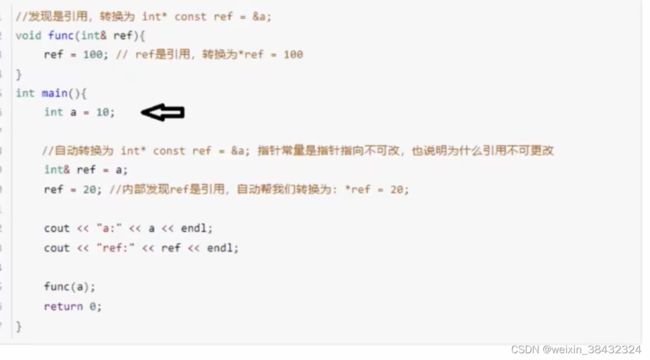C++语法 内存区域 和 引用
代码区
存放函数体的二进制代码 由操作系统进行管理
全局区
存放全局变量和静态变量以及常量 存放全局变量 静态变量 常量(字符串常量 全局const常量)
栈区
由编译器自动分配释放,存放函数的参数值,局部变量等。不要返回局部变量的地址
堆区
由程序员分配和释放 若程序员不释放程序结束的时候由操作系统回收 cpp 中使用new进行开辟内存
new操作符
c++中利用new操作符在堆区开辟内存 需要程序员手动释放。
#include
#include "mathutil.hpp"
#include
using namespace std;
int *func() {
int *p = new int(10);
return p;
}
void test1() {
int *array = new int[10];
for (int i = 0; i < 10; i++) {
array[i] = 100 + i;
}
for (int i = 0; i < 10; i++) {
std::cout << array[i] << std::endl;
}
// 释放数组需要在变量前➕一个【】
delete[] array;
}
int main(int argc, const char * argv[]) {
// insert code here...
std::cout << "Hello, World!\n";
test1();
int * p = func();
std::cout << *p << std::endl;
std::cout << *p << std::endl;
std::cout << *p << std::endl;
std::cout << *p << std::endl;
delete p;
std::cout << *p << std::endl;
return 0;
}
Hello, World!
10
10
10
10
-559071216
Program ended with exit code: 0 引用
给变量起别名
语法 数据类型 &别名 = 原名
#include
#include "mathutil.hpp"
#include
using namespace std;
int main(int argc, const char * argv[]) {
// insert code here...
std::cout << "Hello, World!\n";
int a = 10;
int &b = a;
std::cout << "a=" << a << "b=" << b << std::endl;
b = 100;
std::cout << "a=" << a << "b=" << b << std::endl;
//引用必须初始化
//int &c;
int d = 20;
b = d; //赋值操作并不是更改引用
std::cout << "a= " << a << "b=" << b << "d = " << d << std::endl;
return 0;
}
注意
引用必须要初始化
引用初始化后就不可以更改
引用做函数参数
作用 函数传参时可以利用引用的技术让形参修改实参
优点 可以简化指针修改实参
通过引用参数产生的 效果和按地址传递是一样的 引用的语法更清楚简单
//
// main.cpp
// cpplearn
//
// Created by KING on 2024/2/1.
//
#include
#include "mathutil.hpp"
#include
using namespace std;
void swapNum(int a,int b) {
int temp = a;
a = b;
b = temp;
}
void swapNum2(int* a,int* b) {
int temp = *a;
*a = *b;
*b = temp;
}
void swapNum3(int &a,int &b) {
int temp = a;
a = b;
b = temp;
}
int main(int argc, const char * argv[]) {
// insert code here...
std::cout << "Hello, World!\n";
int a = 10;
int b = 20;
swapNum(a, b);
std::cout << "a=" << a << "b=" << b << std::endl;
swapNum2(&a, &b);
std::cout << "a=" << a << "b=" << b << std::endl;
swapNum3(a, b);
std::cout << "a=" << a << "b=" << b << std::endl;
return 0;
}
引用做函数返回值
不要返回局部变量的引用
Reference to stack memory associated with local variable 'a' returned#include
#include "mathutil.hpp"
#include
using namespace std;
int& test03() {
int a = 10; /// 局部变量在栈区
return a;
}
int main(int argc, const char * argv[]) {
// insert code here...
std::cout << "Hello, World!\n";
int &a = test03();
std::cout << "a=" << a << std::endl;
return 0;
}
函数的调用可以作为左值
//
// main.cpp
// cpplearn
//
// Created by KING on 2024/2/1.
//
#include
#include "mathutil.hpp"
#include
using namespace std;
int& test04() {
static int a = 10; /// 局部变量在栈区
return a;
}
int main(int argc, const char * argv[]) {
// insert code here...
std::cout << "Hello, World!\n";
int &a = test04();
std::cout << "a=" << a << std::endl;
std::cout << "a=" << a << std::endl;
test04() = 1000;
std::cout << "a=" << a << std::endl;
std::cout << "a=" << a << std::endl;
return 0;
}
Hello, World!
a=10
a=10
a=1000
a=1000
Program ended with exit code: 0 引用的本质
常量引用
用来修饰形参防止误操作
//
// main.cpp
// cpplearn
//
// Created by KING on 2024/2/1.
//
#include
#include "mathutil.hpp"
#include
using namespace std;
void printNum(int &num) {
std::cout << num << std::endl;
num = 100;
}
void printNum2(const int &num) {
std::cout << num << std::endl;
//num = 100;
//Cannot assign to variable 'num' with const-qualified type 'const int &'
}
int main(int argc, const char * argv[]) {
// insert code here...
std::cout << "Hello, World!\n";
// 引用必须引用一块合法的内存空间
//int &a = 20;
// 加上const 之后 这里相当于 编译器将代码修改为 int temp = 10; const int &ref = temp;
const int &ref = 10; // 加入const 之后变为只读不可以修改
// 引用本质是指针常量 指针常量 特点是 不能修改指向 只能修改指针保存地址的值
int num = 22;
printNum(num);
std::cout << num << std::endl;
int num2 = 20;
printNum2(num2);
return 0;
}


